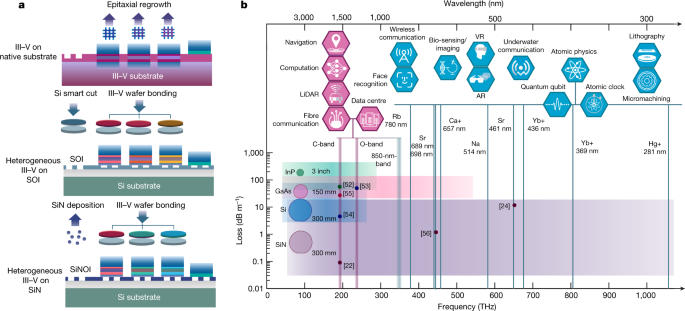2022-12-05 カリフォルニア大学サンタバーバラ校(UCSB)
光の情報とエネルギーは、電子回路の電線のように、フォトニック回路の導波路を通って伝わる。小型化のための大きなハードルは、レーザーとフォトニック回路そのものを接続することだった。しかし、それぞれの経路にレーザーを接続することは現実的ではない。
この「レーザー接続」の問題は、2005年、研究者たちによって、シリコン回路でエレガントに解決された。彼らは、シリコンの上にレーザー材料を接着し、光を導波路に屈曲させることでこの難題を克服した。
しかし、これらの技術には欠点がある。それは、波長が1,100ナノメートルより長い光、つまり赤外線の奥の方にある光にしか使えないということだ。どの半導体にも「バンドギャップエネルギー」と呼ばれるものがあり、これより高いエネルギー(つまり波長が小さい)の光子は材料に吸収される。シリコンのバンドギャップは約1,100nmです。
そこで、最有力候補として浮上したのが窒化ケイ素だ。バンドギャップは約250nmで、紫外域に近い。また、シリコン化合物であるため、電子機器の製造工程に容易に組み込むことができる。また、構成元素であるシリコンと窒素は豊富にあり、安価である。
しかし、レーザーを導波路に接続するという課題には、再度取り組まなければならなかった。シリコンに関する当初の技術は、窒化シリコンの光学特性のために機能しないからだ。光は、通過する物質によって進む速度が異なる。科学者は、物質中の光の速度を屈折率と呼ばれる数値で表しますが、窒化シリコンはレーザー材料と大きく異なる屈折率を持っている。このため、レーザー層からその下の窒化ケイ素の導波路に光線を曲げることが困難であった。
そこで研究チームは、レーザーと同じ面に、窒化ケイ素の屈折率に近い中間材を追加した。こうすることで、レーザー光は遷移導波路に正面から入射し、光学特性の近い材料から窒化シリコンに降り注ぐことができるようになった。
<関連情報>
- https://www.news.ucsb.edu/2022/020782/extending-spectrum
- https://www.nature.com/articles/s41586-022-05119-9
完全集積型フォトニクスの波長域をサブマイクロメートルまで拡大 Extending the spectrum of fully integrated photonics to submicrometre wavelengths
Minh A. Tran,Chong Zhang,Theodore J. Morin,Lin Chang,Sabyasachi Barik,Zhiquan Yuan,Woonghee Lee,Glenn Kim,Aditya Malik,Zeyu Zhang,Joel Guo,Heming Wang,Boqiang Shen,Lue Wu,Kerry Vahala,John E. Bowers,Hyundai Park & Tin Komljenovic
Nature Published:28 September 2022
DOI:https://doi.org/10.1038/s41586-022-05119-9

Abstract
Integrated photonics has profoundly affected a wide range of technologies underpinning modern society1,2,3,4. The ability to fabricate a complete optical system on a chip offers unrivalled scalability, weight, cost and power efficiency5,6. Over the last decade, the progression from pure III–V materials platforms to silicon photonics has significantly broadened the scope of integrated photonics, by combining integrated lasers with the high-volume, advanced fabrication capabilities of the commercial electronics industry7,8. Yet, despite remarkable manufacturing advantages, reliance on silicon-based waveguides currently limits the spectral window available to photonic integrated circuits (PICs). Here, we present a new generation of integrated photonics by directly uniting III–V materials with silicon nitride waveguides on Si wafers. Using this technology, we present a fully integrated PIC at photon energies greater than the bandgap of silicon, demonstrating essential photonic building blocks, including lasers, amplifiers, photodetectors, modulators and passives, all operating at submicrometre wavelengths. Using this platform, we achieve unprecedented coherence and tunability in an integrated laser at short wavelength. Furthermore, by making use of this higher photon energy, we demonstrate superb high-temperature performance and kHz-level fundamental linewidths at elevated temperatures. Given the many potential applications at short wavelengths, the success of this integration strategy unlocks a broad range of new integrated photonics applications.



